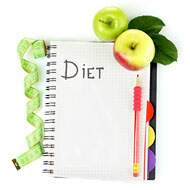Yoga Menu Plans
Even though there aren't any fixed menu plans in Yoga you could use these guidelines to maintain dosha balance in your body and restore their balance as required, regardless of your basic constitution.
The three doshas (or humors in the human body) are also known to influence the movement of thoughts, feelings, prana flows, nerve impulses, and fluids in our body.
Yoga recommends:
- Warm food, moderately heavy textures, added butter and fat.
- Salt, sour, and sweet tastes, as they are considered soothing and satisfying foods.
- All soothing foods are considered good. As far as possible, have warm milk, warm soups, hot cereals, cream, butter, stews, and fresh baked bread. Also increase warm, nourishing foods since these are good for stabilizing the doshas in the body. On the other hand cold foods like cold salads, iced drinks, raw vegetables and greens aren't very good for persons with vata imbalance.
- In Yoga, breakfast is highly recommended. Have breakfast which is warm, milky and sweet like hot cereals such as cream of rice or wheat.
- Have hot or herbal teas with snacks late in the afternoons. Keep away from drinks high in caffeine.
- Have warm, moist foods like cooked grains and cereals, hot oatmeal or steaming, hot vegetable soup.
- Yoga considers warm milk good. If you like, you can add a little sugar or honey to it.
- Always have warm or hot water instead of iced water or iced drinks.
- Go in for salted nuts which are heavy and oily as opposed to dry salty snacks.
Grains
| Prefer | Reduce or avoid |
| Oats (as cooked oatmeal cereal, not dry) | barley |
| cooked rice | buckwheat |
| wheat | corn |
| dry oats | |
| millet | |
| rye |
Vegetables
| Prefer | Avoid or reduce |
| Asparagus | Brussels sprouts |
| Beets | cabbage |
| Carrots | cauliflower |
| Cooked vegetables | broccoli |
| Cucumber | celery |
| Garlic | eggplant |
| Green beans | leafy green vegetables |
| Leafy greens in moderation | tomatoes |
| Onions, cooked | mushrooms |
| Onions, cooked | peas |
| Radishes | potatoes |
| Sweet potato | peppers |
| Turnips | sprouts |
Note: All the above vegetables are alright if they are cooked with oils, but for cabbage and sprouts.
Fruits
| Prefer | Avoid or reduce |
| Apricots | apples |
| Avocados | cranberries |
| Bananas | pears |
| Berries | pomegranates |
| Cherries | |
| Coconut | The above fruits are OK cooked |
| Fresh figs | Avoid dried fruits, in general and unripe fruit (especially bananas) |
| Grapefruit | |
| Grapes | |
| Lemons | |
| Mangos | |
| Papaya | |
| Peaches | |
| Pineapple | |
| Plums | |
| Sour oranges | |
| Sweet fruits | |
| Sweet melons | |
| Sour fruits | |
| Stewed fruits |
Beans
| Prefer | Avoid or reduce |
| Chickpeas | None |
| Mung beans | |
| Pink lentils | |
| Tofu (small amounts) |
Dairy
All Dairy is acceptable
Oils
All oils are acceptable. Then again, sesame oil and olive oil are considered particularly good.
Sweeteners
All are acceptable
Nuts and Seeds
All are acceptable in small quantities. Then again, almonds are considered best.
Herbs and spices
Almost all herbs and spices are acceptable within moderation, with emphasis on sweet and/or heating herbs and spices. Then again, you must avoid using spices in large amounts. Curtail or avoid the use of all bitter and astringent herbs and spices like: coriander seeds, fenugreek, parsley, saffron, turmeric.
In summation
Breakfast is normally considered desirable. Have hot, sweet and sour foods. Decrease quantities of dry and bitter foods. Increase warm or hot water and drinks, raw nuts and nut butters. Use spices: cinnamon, cardamom, cumin, ginger, cloves in moderation.
Yoga Detox Diet Plan
Almost everyone is aware of the fact that the food we eat has a major impact on our bodies and our overall health. Yet, due to a hectic lifestyle, unhealthy food, such as fast food, instant dinners, processed foods and takeaway meals have become a regular feature in our daily diets. These foods may be filling, but they are usually high in fat and calories and low in nutrition. Moreover, many of them interfere with the digestive process, which causes the toxins and the impurities in the blood to build up. Therefore, people who are getting conscious about their health have now started following a detox diet, to flush out these toxins that have gathered in the body. There are several different detox diet plans and menus that people can use, for this purpose. Many people have also started turning towards the yoga diet plan for cleaning their bodies. One of the main advantages of a yogic diet plan is that it requires people to consume a wide variety of organic foods. Moreover, people who are following yoga diets tend to consume balanced meals, thereby improving their overall health.
This is why a yoga diet menu plan can be followed on a more long term basis. Just like there are different yoga styles that people can practice, like power yoga, bikram yoga, hatha yoga and so on, there are different yoga diets too, that people can choose from, such as the power yoga diet plan, the bikram or hot yoga diet plan and the hatha yoga diet plan. Many people who have tried yogic diets refer to them as detox diets that work. There are different sheaths or koshas in yoga, which help the human body in many different ways. Many people follow a yoga diet for weight loss, even though that is not really the main objective of the diet. Yoga usually promotes fasting and consuming detox diet foods. One of the main principles of a yoga detox diet menu plan is eating in moderation, without overdoing it at any point. Therefore, in order to increase the success of the yoga diet menu on the body, people should make sure that they:
- Only eat till they fill their stomachs to 2/3 of its full capacity. This practice should be incorporated for all meals. One of the best ways to do so is by eating slowly and chewing the food completely, before swallowing it.
- Eliminate unnecessary snacking in between meals, especially high calorie snacks. Since fasting is an integral part of a yoga detox diet menu, people are advised to gradually cut down on the number of meals they consume in a day, till no more than 3 meals are eaten, inclusive of snacks.
- Increasing the quality of food that is eaten, which means that the food should be organic and must contain minimal amounts of preservatives, additives, pesticides and herbicides.
Most people are under the impression that yoga diet recipes will include foods that are bland and tasteless, but nothing could be further from the truth. A yogic diet menu not only includes a variety of fruits, vegetables, grains, cereals, nuts, seeds and dairy products, but also several healthy herbs and spices, which can enhance the flavor of the food. Unlike other diets, a yoga menu will not dissect the foods into vitamins, minerals, carbs, fiber, protein and so on. The main objective of the yogic diet is to provide the body with wholesome and balanced meals at all times. In fact, the yoga diet does not even require a person to be vegetarian. But with the regular practice of yoga, most people prefer to follow vegetarianism, as non vegetarian food a bit heavy and difficult to digest. Given below are some of the food items that are generally recommended by a yoga detox diet to cleanse the body:
- Garbanzo beans, chickpeas, soy bean, lentils, mung beans, tofu and other similar healthy beans
- Health spices, such as cumin, cloves, cinnamon, cardamom and ginger. Cooking food with too many spices should be strictly avoided.
- Fresh Fruits, like oranges, melons, papayas, pineapples, grapefruit, lemons, berries, coconut, plums, avocadoes, mangoes, peaches, figs, grapes, bananas, cherries, apricots and most other healthy fruits
- Certain cereals and grains like wheat and cooked oats as well as rice
- Herbs, to add taste and flavor to the food, especially sweet herbs or those herbs that have healing properties. Bitter herbs, like turmeric, fenugreek, parsley and coriander should be avoided as far as possible.
- Most dairy products like milk, cottage cheese and yogurt
- Certain oil, especially the healthier ones like olive oil or sesame oil
- Most fresh vegetables, which include radishes, turnips, asparagus, sweet potatoes, onions, garlic, leafy greens, green beans, beets, carrots and cucumbers
There are several yoga detox diet recipes that are easily available through online resources and recipe books. However if you are looking at methods that include yoga diets to lose weight in 7 days, then you are mistaken as thus is a gradual process and takes time. A yoga detox diet has many advantages and is helpful in dealing with conditions such as acne as also arthritis. Given below in an example of a yogic recipe that can help detoxify the body:
Detox Diet Recipe Baba Ganoush
Ingredients
- 1 Medium-sized eggplant
- 1 Piece of ginger
- 1½ Lime
- 2 Tablespoons tahini paste
- 2 Teaspoons olive oil
- A few cloves of garlic
- Salt to taste
Method
- Squeeze the juice out of the limes and keep it aside
- Wash the eggplant thoroughly, cut its stem and make small cuts in it. Place the cloves of garlic into these cuts
- Put the eggplant on a skewer and roast it, on a low flame, till its skin turns brown and stem arises from the cuts.
- Once the garlic is roasted, take off its skin and place the fleshy part, along with the garlic, into a bowl.
- Add the tahini paste also known as sesame paste and salt and mix the ingredients.
- Pour the lemon juice and the olive oil too, before mixing all the ingredients well.
This dip tastes very good, with pita bread.
It is absolutely essential for all people to consult a doctor before making any dietary or lifestyle changes, regardless of their age, gender or levels of physical fitness. However, this is all the more important for people who are elderly or are suffering from any preexisting medical condition, like diabetes. A yoga diet could have an adverse effect on diabetics, since it advises people to consume no more than three meals a day, which could lead to low levels of blood sugar in diabetics. Therefore, before following a yoga diet, it is best to get an approval from a doctor.



